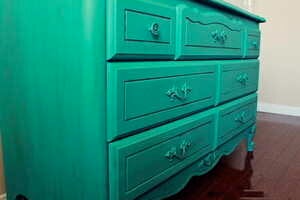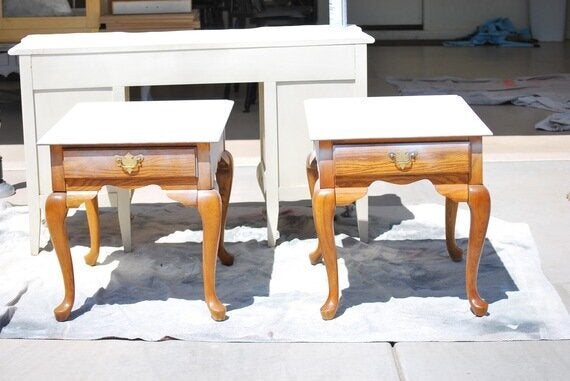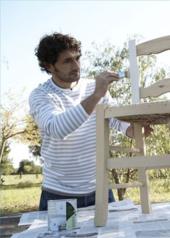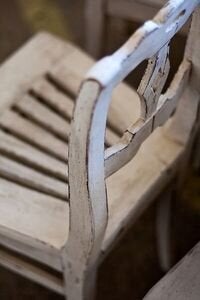Old furniture comes in two categories: a shabby old piece you fell in love with at a second hand store that just needs a little bit of love, or, more likely, a piece you got ages ago when you were broke and is now a horrible eyesore in your home.
Thankfully, old pieces of furniture can be given a new lease of life with just a lick of paint. Once made over and bought up to date, these pieces will continue to be useful for many years to come.

If you have a new colour scheme, or fancy a different look on a budget, tired and unwanted furniture can look amazing with a simple paint makeover. It isn't just dressers and wooden chairs that can be painted, but wooden kitchen cupboards and bedroom cabinets too. It takes a little elbow grease, but for a small investment, you can turn dated furniture into something beautiful that suits your exact taste.
Preparing your Furniture:
Before applying paint to your furniture, you must properly prepare the wood to ensure that the paint adheres and a smooth even coating is achieved. The first step is to give your doors or furniture a really good wash down to remove any dust or grime. Once dry you should look at 'roughing' up the wood (not to be confused with making new wood look old) by stripping off the top layer and any finishes that may have been previously applied. If you wood is wax finished then you will need to buff it with wire wool and a small amount of white spirit. Varnish should be rubbed over with sandpaper. When preparing your wood, remember to stay safe and work in a ventilated area with your mouth properly covered.

Once your furniture has been stripped, wash it down again to make sure there is no dust left on your item and leave it to dry for a few hours.
Priming your Furniture
Not all wooden furniture needs primer, but it is recommended for an even, good quality finish. Primer is used where a completely smooth and flat surface is not present. Older pieces and doors tend to have lots of bumps, chips and depressions from years of wear and tear and so a primer is essential. Primer protects both the wood and the paint and stops moisture (which could cause warping, rotting and peeling) getting into either material. Primer also works as a fantastic undercoat for lighter colours and could mean the difference between having to apply two coats of coloured paint or several.
The type of primer you use will be dependent on the state of your wood. Use oil based primer on wood that has been previously painted, a high quality latex or oil based primer on very worn and weathered wood or for wood that is marked, used a stain blocking primer. Check the tin to find out how long the primer takes to dry and the recommended time period to wait before applying your top coat.
If you are distressing your furniture later, primer is not as essential. Leave your primer to dry before layering your paint.

Painting your wooden furniture will probably require more than one layer, depending on the state of the wood and the amount of primer used. Make sure the coats are thin, as layering up thin coats gets a much better finish than one thick layer. It takes time, but the results will last much longer.
For a shabby chic or farmhouse style kitchen, you can layer two complimentary colours on to your cupboard doors. Adding a layer of lilac for example, and layering it with a thin layer of grey means your wood will have a distressed look.
Tips When Painting Your Furniture:
When applying your paint, paint in the direction of the wood grain.

Make sure your thin layers are even by ensuring there is no paint left on the brush when you dip it back in the can.
Keep all pets away from the area where you are painting your furniture - pet hair can get stuck in your paint finish, for a less than desirable look!
Use a high quality paint brush so that bristles do not fall out and become lodged in your nice new coat of paint.
Using a Wax or Glaze
If you want to give your wood an antique look then this can be achieved through glazing or waxing your piece.
If waxing, once your wood is dry you should start by giving it a full coating of clear wax. Clear wax prepares the surface of your wood for you to apply your antiquing dark wax and will mean that the dark wax can be moved and manipulated easily. Whilst your clear wax is still drying, use a brush to apply a very small amount of dark wax into the crevices of your wood (into door mouldings or furniture joins). Take a cloth and rub off some of the dark wax just applied. Remove your dark wax with your rag until you are happy with the depth of the rustic colour.

For glaze you should start by painting glaze into any carved areas with a small paintbrush. Once these are done you can then move on to the flat areas. As with the wax, take a rag and wipe most of the glaze off making sure you wipe in the direction of the wood grain. Repeat this process until you achieve the desired finish.
Once you have mastered these techniques you will find that you can paint any wooden surface to create pieces that will transform your rooms. Painted wood is bang on trend with French, shabby chic and rustic styles being very much in vogue for home décor in 2014. The trendiest colour at the moment is denim blue and is a good one to get started with on your first wood painting project!